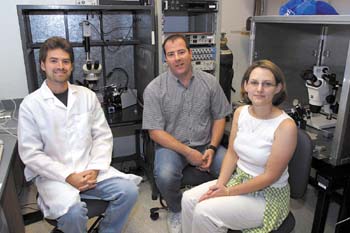
R. Jason Pitts, left, and A. Nicole Fox were co-authors of the paper with Zwiebel. (photos by Neil Brake)
Eskind offers Web tools for VUMC
Eskind Biomedical Library (EBL) is introducing a suite of three Web-based tools, or “shells,” to enable VUMC Web users to present, locate, retrieve and reuse information more easily. The tools ultimately will aid knowledge management at VUMC.
“Knowledge management is focused on treating knowledge as a commodity and using tools and processes to help increase information access and reuse,” said Annette Williams, EBL’s assistant director for knowledge management. The strategy involves teaming up librarians, with their knowledge of how information is sought, properly indexed and classified, with computer programmers practiced in the development of Web applications.
“VUMC departments and groups have a need to create various Web-based products. Our Library Director, Dr. Nunzia Giuse, has established a unique approach that seeks to facilitate these group projects with reusable tools that will benefit a broader audience,” Williams said.
The new tools are Web shells that departments and individuals can use to present information — a directory shell, a news publishing shell, and a learning module shell. No Web development, design or programming experience is required. “If you can use a word processor, you can use the shells,” said John Clark, health systems analyst-programmer. “We allow users to spend their effort on content rather than on Web development.”
Regardless of the varied Web formatting that different groups and individuals may apply to their information, shell content is stored neatly in a database on an EBL server. Indexing is the first element necessary to realize the knowledge management benefit and content reuse. Content indexing by librarians yields data sets that allow more efficient and refined information retrieval.
Optimum dissemination and reuse comes when knowledge is treated as a sharable commodity. “Assimilating existing VUMC knowledge into new products has the potential to enable faster and more economical knowledge discovery within the VUMC community,” Giuse said. With the shells, departments can serve their objectives while also serving the institutional objective of improved knowledge management.
Each of the three tools accommodates users with varying technical skills and design capabilities. The shells impose no limitations on content or design. Information posted to the shells becomes part of the institution-wide, sharable knowledge repository.
• The directory shell allows groups to create their own directories using source code derived from the online VUMC Physician Referral Directory.
• The news publishing shell is designed for serial publication of news and information; the online version of the Reporter, a product of the EBL Web Team, served as the basis for the creation of this tool.
• The learning module shell serves as a flexible template for the delivery of Web-based tutorials, accommodating text, images, video, and PDFs, as well self assessment features and recorded quizzes. While converting an EBL-authored pathology lesson program (Virgil) from a Mac-based tool to a Web accessible one, the EBL recognized the value of writing the code in such a way as to make it reusable for other projects.
Eskind Web experts are available to assist with application of the knowledge management tools.
• Directory shell — contact Annette Williams, 6-1553, or Taneya Koonce, co coordinator, Web team, 6-3104.
• News publishing shell — contact John Clark, john.clark@vanderbilt.edu.
• Learning module shell — contact Kim Day, computer programmer, kim.day@vanderbilt.edu.













